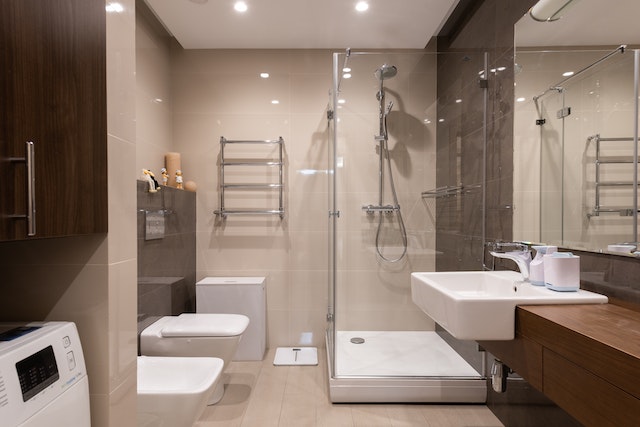A well-planned bathroom is a worthwhile investment, whether it’s a compact en suite or a spacious spa-style wet room. Bathrooms, whether full or half bathrooms, en suites, or just cloakrooms with WCs, and the amount of luxury you can afford, will therefore likely be high on your list of considerations when self-building a home. If you’re building a new house, you can customize the layout of the bathrooms to suit your preferences, down to the location of the pipes and drains.
An architect’s input during the project’s design phase will be invaluable. Before any construction can begin, the internal layout must be finalized so that drainage and other pipework can be installed in their proper locations. They could also make a 3D model that lets you outfit and decorate digital dwellings.
Before you make too many decisions, read our guide to choosing a bathroom for your self-build…
Bathroom Placement
Bathrooms in new constructions are often stacked, placed back to back, or placed closely together to maximise drainage. Additional pipes will need to be constructed to supply the sanitaryware and collect waste if you plan to add a new bathroom at a later date..
Space
Think about how much room you’ll need for each fixture, such as at least a meter and a half alongside a bathtub or shower. It will be uncomfortable and difficult to move around if things are crammed in too tightly. Doors that swing outward or slide open are great space savers, and open bathrooms that are a part of a bedroom (often screened by a partial wall) are becoming more and more common.
The WC
A macerator pumping system can be used to decrease the solid waste and pump it through a smaller diameter pipe to the main soil stack if the WC would be too far from an existing sewage stack. This makes it possible to put a bathroom in an area where installing a large diameter pipe would be costly or difficult. Macerators have a bad rap for being loud, but modern plumbing only requires the motor to run for a few seconds per flush.
Showers
Where the hot water is coming from will determine the size of the inlet pipe needed for the shower. Since an electric shower can rapidly heat water from cold, only a cold water inlet pipe is required. This facilitates their installation, making them a favorite among plumbers. The plumbing for a mains shower can be installed either underground or on the wall. Traditional ‘gravity-fed’ plumbing, which often receives its water supply from a header tank in the attic, provides weak water pressure, especially in the shower. Installing a booster pump to increase efficiency or opting for a house-wide unvented plumbing system that uses mains-pressure hot water to supply fixtures is one way to circumvent this problem. In order to provide hot water on demand, a combination (combi) boiler, thermal store, or specialized cylinder can be utilized. Be sure your shower meets the minimum water pressure requirements before using it. A large shower area can make even a modest bathroom appear grand.
Ventilation
The condensation that forms in most bathrooms can be greatly reduced by installing an extractor fan in a window or on an exterior wall. When possible, opening roof lights are preferable than fixed windows because of the area they save on the building’s exterior.
Wet Rooms
If your bathroom is cramped or oddly shaped, a wet room may be the best option because it creates the illusion of more space, is easier to clean, and allows for greater mobility, particularly if you choose a wall-mounted toilet and sink. A wet room is convenient for families with young children and may be used by the elderly or the disabled without difficulty. Wet rooms used to only be feasible on the ground floor and required a concrete or screed basis, but with the development of better waterproofing solutions such floor membranes and shower floor formers, they may now be installed everywhere, regardless of size. If there isn’t enough room under the floor to provide enough fall for the waste pipe, constructing a drain can be tricky in some structures, but a pumped drain can typically help.
Electrics
Before installing the plumbing and sinks, it is important to arrange and install the electricity so that it can be hidden. Lighting fixtures that aren’t IP-rated, whether they’re free-standing, hanging, or adjustable, should be avoided. The most secure choices are recessed lighting and hermetically sealed lamps. No plug or socket fittings (apart from special razor sockets) are allowed in bathrooms, and no switches (except from ceiling pull cord kinds) may be installed anywhere within reach of anyone using a bath or shower. Each area of a bathroom needs its own unique IP rating, so be sure to consider that while shopping for lighting. This displays how well you are shielded from water, from total immersion to just splashes.
Fittings
Bathroom suites can be found in a broad variety of colors and designs, but you should exercise caution when deciding on bold hues or oversized fixtures. You should always test out the tub in a new bathroom set to make sure it fits your needs. Make sure everything can fit up the stairs and that there’s enough room to walk around in the bathroom. If you want to free up some floor space, consider mounting your sinks and toilets on the wall. It is feasible to acquire a bracing frame in addition to a WC unit, which will then house a concealed system, if your walls are too flimsy to sustain a wall-hung system.
Storage
Storage options include cabinets on the wall, freestanding shelves, and drawers placed beneath the sink. Bathrooms that are free of unnecessary items are more aesthetically pleasing and easier to clean, and always give the feeling of luxury.
It’s understandable that self-build homeowners would feel stressed out by the prospect of creating a brand new residence from scratch. It’s easy to lose sight of details that could make a big difference in the final product, but with our handy and helpful guide you will have the bathrooms covered.





